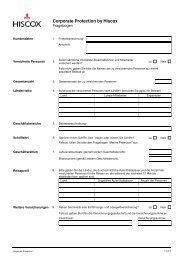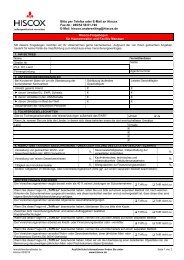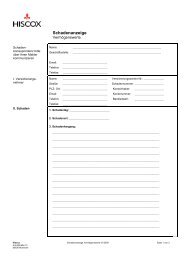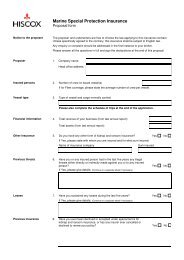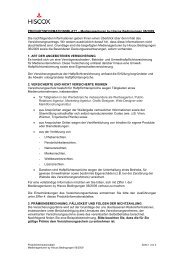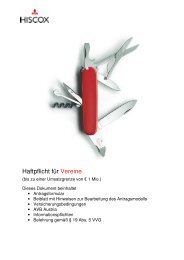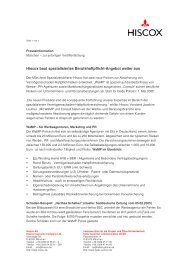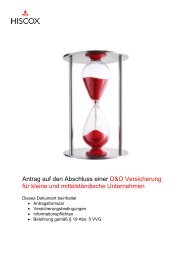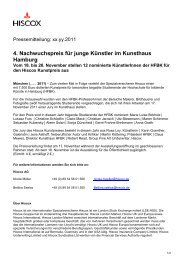Download PDF - Hiscox
Download PDF - Hiscox
Download PDF - Hiscox
Create successful ePaper yourself
Turn your PDF publications into a flip-book with our unique Google optimized e-Paper software.
Risk management<br />
The risk management framework extends<br />
to all aspects of risk including insurance,<br />
market, credit, operational, liquidity,<br />
environmental, ethical and strategic risks.<br />
The core business of <strong>Hiscox</strong> is dealing<br />
with risk. The understanding of risk is<br />
intrinsic to every level of decision-making<br />
in the Group.<br />
The risks associated with the core business<br />
represent some of the greater exposures,<br />
however the Group is exposed to a number<br />
of other risks and has systems and procedures<br />
to identify and manage them. These procedures<br />
are regularly reviewed and improved in the<br />
light of the changing risk environment and<br />
best practices. Risk appetite is set by the main<br />
Board and cascaded down into the Group’s<br />
global operations as part of the business<br />
planning cycle and through various risk<br />
and operational committees. These are:<br />
Risk Committees<br />
Underwriting Review Group<br />
Reinsurance Purchase Review Group<br />
Reinsurance Security Committee<br />
Cash Flow Review Group<br />
Broker Credit Committee<br />
Investment Committee<br />
Reserving Committees<br />
Business Continuity Committee.<br />
These committees are all chaired by either<br />
the Chief Executive, Chief Financial Officer<br />
or Chief Underwriting Officer and have specific<br />
areas of focus, such as underwriting,<br />
reinsurance purchase and security, liquidity,<br />
broker credit risk, investments, claims reserving<br />
and business continuity. Senior management<br />
responsibilities are clearly defined together<br />
with their reporting lines and the execution of<br />
delegated responsibilities is closely monitored<br />
by reporting to the Board and its committees.<br />
This monitoring, supported by financial and<br />
non-financial management information,<br />
assesses performance against agreed targets<br />
and objectives, as well as the risks to achieving<br />
these objectives and the effectiveness of<br />
the measures in place to manage these risks.<br />
In parallel with these direct risk management<br />
processes, there is a dedicated risk management<br />
function which, in conjunction with Internal<br />
Audit and the Group risk committees, monitors<br />
and reviews the effectiveness of risk management<br />
activities throughout the organisation and<br />
reports to the Board. These functions are<br />
organised centrally to assist in the integration<br />
of best practice throughout the Group. A range<br />
of risk management tools is used to assess<br />
and manage risk both at business unit level<br />
and on a Group-wide basis.<br />
Major risks<br />
The major risks that the Group faces are<br />
presented below. Detailed information on the<br />
major risks and uncertainties impacting the<br />
Group’s financial statements is set out in<br />
note 3 to the financial statements.<br />
Insurance<br />
Catastrophe and systemic insurance losses<br />
The Group continues to underwrite significant<br />
risks in geographical regions that are prone to<br />
natural peril. This business remains a compelling<br />
proposition for the Group since it is capable<br />
of returning good margins over the medium<br />
to long-term as the occurrence of catastrophes<br />
averages out. As with similar insurers, the<br />
Group’s earnings are affected by unpredictable<br />
external events such as natural and other<br />
catastrophes, legal developments, social and<br />
economic change and the emergence of latent<br />
risks. Such events can create significant levels<br />
of underwriting losses. The Group manages<br />
its exposure to these risks through having<br />
a clearly defined risk appetite which dictates<br />
the business plan and is realised through<br />
disciplined underwriting, close and continuous<br />
monitoring of exposures and aggregations,<br />
and a prudent and disciplined reinsurance<br />
purchase programme to cap losses from<br />
risk concentrations.<br />
Of critical importance is the quality of our<br />
underwriting models and risk aggregation<br />
capability. Incentives ensure that underwriting<br />
staff make sound and objective judgements<br />
that are aligned with the Group’s overall strategic<br />
objectives and risk appetite. Clear authority<br />
limits are also in place that are regularly<br />
reviewed and monitored. Policy wordings<br />
are reviewed regularly by specialists and legal<br />
experts in the light of legal developments to<br />
ensure that the Group’s exposure is restricted,<br />
as far as possible, to those risks identified<br />
at the time of policy issuance. The modelling<br />
and monitoring tools are used both in the<br />
underwriting process and by independent risk<br />
specialists. They are used to design the insurance<br />
and reinsurance programmes and control the<br />
business underwritten to ensure that the risk<br />
profiles of contracts match the exposures<br />
for which the programmes were devised.<br />
Incentives ensure<br />
that underwriting<br />
staff make sound<br />
and objective<br />
judgements that<br />
are aligned with<br />
the Group’s<br />
overall strategic<br />
objectives.<br />
Risk management <strong>Hiscox</strong> Ltd Report and Accounts 2009<br />
21




